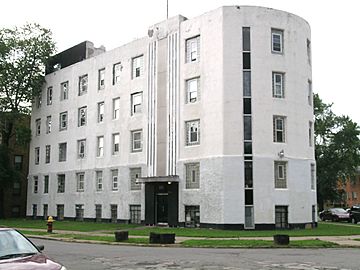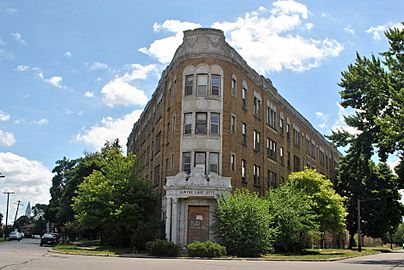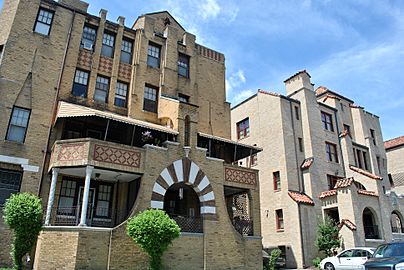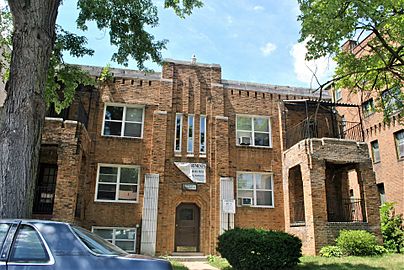Palmer Park Apartment Building Historic District facts for kids
Quick facts for kids |
|
|
Palmer Park Apartment Building Historic District
|
|
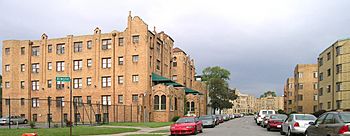
Streetscape at Whitmore and Alwyne
|
|
| Location | Detroit, Michigan, U.S. |
|---|---|
| Built | 1925 |
| Architect | Multiple; Arnold & Fuger et al. (boundary increase) |
| Architectural style | Mixed (more Than 2 Styles From Different Periods); International Style, Colonial Revival (boundary increase) |
| NRHP reference No. | 83000895, 05000014 (boundary increase) |
| Added to NRHP | May 21, 1983; February 11, 2005 (boundary increase) |
The Palmer Park Apartment Building Historic District is a special neighborhood in Detroit, Michigan. It is known for its many beautiful apartment buildings. You can find it near Pontchartrain Boulevard, McNichols Road, and Covington Drive. Later, its eastern edge was extended to Woodward Avenue.
This district has some of the most fancy and diverse apartment designs in all of Michigan. Because of its unique buildings, it was added to the National Register of Historic Places in 1983. This list recognizes important historical places in the United States.
Contents
History of Palmer Park Apartments
The land where this historic district stands was once part of a large estate. This estate belonged to Thomas W. Palmer, a very wealthy man from Detroit. He was also a US Senator for a time. Palmer had big plans to develop this area. However, he passed away in 1913 before he could start.
After Palmer's death, Walter Briggs bought this part of the estate. In 1925, Briggs hired the famous architect Albert Kahn. Kahn designed one of the first apartment buildings in the area. This building, at 1001 Covington, was later turned into condos in 2005.
About 40 buildings were built in the district in total. Many different architects worked on them. Most of these buildings were constructed in the 1920s and 1930s. However, new buildings continued to be added until 1965.
At one time, Palmer Park was home to a large and vibrant community. Many businesses like shops and restaurants were owned by people from this community. It was said that to get an apartment there, you often needed to know someone already living in the complex.
In the 1980s, the area faced more challenges. Because of these changes, many residents began to move away. People often moved to nearby towns like Ferndale and Royal Oak. The beautiful apartment buildings are still there today. The "Hotter Than July!" festival is still held in Palmer Park. This event celebrates the community and its history.
Architecture and Design
The buildings in the Palmer Park district were made for middle- and upper-middle-class families. Most of them are five or six stories tall. They included the newest living technologies of their time.
The architecture here is very exciting and diverse. You can see many different styles from around the world. Some buildings look like they belong in ancient Egypt or Spain. Others have a Mediterranean or Venetian feel. There are also buildings that look like old English Tudor homes. Some even have a Moorish Revival design. You can also find simpler, modern styles from the 1930s. These include Art Moderne and International Style buildings.
Notable Buildings in the District
- Temple Israel: This building was constructed in the 1950s. It is now used as a church.
- Palmer Park Chapel of The Church of Jesus Christ of Latter-day Saints: This building was first built for a Greek Orthodox Church.
Education in Palmer Park
Students living in Palmer Park attend schools within the Detroit Public Schools district. For elementary and middle school, residents go to Palmer Park Preparatory Academy. This school was once known as the Barbara Jordan School. All high school students in the area attend Mumford High School. Palmer Park Preparatory Academy is run by teachers, not by a principal.
Gallery
See also
 In Spanish: Distrito Histórico de Palmer Park Apartment Building para niños
In Spanish: Distrito Histórico de Palmer Park Apartment Building para niños


